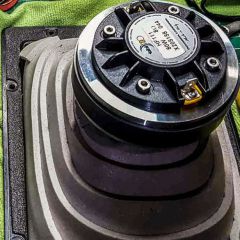-
Posts
580 -
Joined
-
Last visited
Content Type
Forums
Events
Gallery
Everything posted by MechEngVic
-
...Until you consider that radio waves, and other electromagnetic waves, are everywhere, and your long lengths of speaker wires are acting just like antennae and picking up the stray signals being emitted by the countless sources of EMI including your power cables, cell phones, and yes even your AM and FM. Maybe an electronics or physics class would help you understand. Then you'd see that the only ludicrous thing is your airplane analogy.
-
It's kind of disappointing that this subject always ends up as "Zip cord VS 20,000$ cables". Anyone who say basic 2 strand copper cables is all you need because PWK said so is wrong, and anyone who buys 20,000$ cables is rich and wrong. The truth is somewhere in the middle. The wires in any set of cables exhibit inductance, resistance, and capacitance, and how a manufacturer or DIY'er deals with it can make an audible difference. It doesn't have to be expensive but it should be better than 2-strand. This video is a great example:
-
This made me drool a little bit.
-
These are them. The caps don't unscrew without enough effort to possibly damage them. Replacing the whole post would require removing the binding post cup, loosening the crossover, disconnecting the wires and removing the posts, no soldering required. That part's up to you. They're yours if you want them.
-
I just had a thought, I have a bunch of binding posts laying around, let me dig around.
-
I haven't seen caps for sale by themselves. Buying posts for just the caps isn't expensive but without knowing post diameter and thread specs, it'll be hard. I don't remember listings for binding posts having this info. What about using banana plugs on your speaker wires? Have you tried contacting Klipsch?
-
Many things affect how you'll hear the low frequencies coming from your speakers. A room is full of nodes and nulls. You'll hear more or less low Hz just by moving around the room. And your speaker placement will affect the position of these nodes and nulls. The best you can do is to get the best low Hz sound in your sweet spot. For these reasons, and since you feel low Hz as much or more than you hear it, you don't want to evaluate your speaker's low frequency response by ear. Use a mic and REW to do it. I'm 49 and my high frequency cuts out at about 14,000Hz.
-
Try toeing in 45 degrees with the speakers straddling the corners, a foot between the corner to the center back of the speaker, if bass is too boomy or the imaging is too narrow, try moving them away from the corner and/or decreasing the toe in angle. Moving the speakers into the room can increase 3D imaging, but may lower bass response. Make it a point to try several positions.
-
Since the lower frequencies are less directional, you might get decent reproduction with just the horns toed in. Try it.
-
I've been comparing tracks in 16/44.1 vs 24/96, and in the majority of tracks I could hear no difference. But in the few tracks where perceived a difference, I would describe it similar to how Chris A described it; they sounded more "breathy", or like the decay of sounds was lasting longer. I was wondering if it was remastering I was hearing and not the change in resolution.
-
Film and foil, PIO, and high end metalized (ClarityCap). Don't use all one type. If you spend too little, you'll always wonder if you could've had a better sound. If you spend too much, you won't have enough money for new music!
-
https://www.audiogon.com/listings/lisa2a90-dynaco-un-limited-by-will-vincent-mondorf-caps-tube
-
Can you tell us what you don't like about Mundorfs?
-
There is a world of difference between producing sound and RE-producing sound. We try to get the best resolution out of even older recordings, though even the best systems only get so close. For example, a photograph can be taken of an object with little detail or much detail, but regardless of the detail of the subject, the photograph will never completely capture it. And yet, we still strive to develop a higher resolution photograph.
-

[NEW GUY ALERT] Tire Kicking: Cornwall IV & Heresy IV
MechEngVic replied to Moosh Bronsun's topic in 2-Channel Home Audio
IMO, the mid and high frequency drivers have to be at ear level. No amount of tilting will fix that. Our brains know exactly where the sound is coming from. Get those H's pointed right at your head, toed in and level, and they will come alive. -
I just bought a Soncoz LA-QXD1, designed and built by the guy behind the khadas Tone Board. A 200$ DAC with balanced XLR and RCA outputs, ES9038Q2M chip with the distortion hump eliminated, 32-bit 768kHz / DSD512 capability, USB, Toslink, and Coax inputs, and digital volume control so you can use it as a preamp. The SQ is an improvement over my Topping D30. Amir over at science review rates it highly. Hard to beat for 200 bucks! https://www.audiosciencereview.com/forum/index.php?threads/soncoz-la-qxd1-balanced-dac-review.13459/
-

DIY Wooden K400 Horns - Help Connecting Driver?
MechEngVic replied to Robbie010's topic in Technical/Restorations
Imagine a triangle with the three corners containing your speakers and you. If the speakers are 40" apart, and they are toed in 45 degrees, then the sweet spot with be at 20" back and center. As you toe the speakers out, the sweet spot will move back in proportion to the laws of trigonometry. Try to keep them toed in as much as possible to avoid reflections of the side walls. -
My introduction to Pink Floyd came in the back of a carpet padded van with a 6x9 speaker in every corner, a significant measure of THC coursing through my veins, and the cash register from "money" spraying coins across an imagined landscape. I was hooked. To Plink Floyd. My favorite song is the current stand out at any particular point in my lifelong journey of exploration of their work. My current favorite is "Fat Old Sun", from the 1970 album "Atom Heart Mother".
-
45 degrees toed in. Pointing right at your face. If the speaker is too bright, it's not the position's fault. Your system needs tuning. Toeing out will create tons of reflections, and that's mostly what you'll hear. You'll only hear off-axis sound coming directly from the speakers. This might create an interesting ambient sound that is pleasant, but it won't be accurate sound reproduction.
-
I would try a different repair shop. If it is an electronic issue, any competent technician should be able to troubleshoot and repair them.
-

Pathos classic one MKIII tube rolling
MechEngVic replied to celestial_sound's topic in Talkin' Tubes
http://www.nostubestore.com/2011/10/mullard-ecc88-6dj8-great-britain.html I can't recommend this website personally, but I haven't heard anything bad. Definitely check out Jim Mcshane http://www.mcshanedesign.net/ If he's got them, they're good. He'll give you viable options for other brands if he doesn't have any. -

TUTORIAL on SOLDERING work upgrading CROSSOVERS?
MechEngVic replied to edzu1234's topic in Technical/Restorations
Good point about cutting leads. -

TUTORIAL on SOLDERING work upgrading CROSSOVERS?
MechEngVic replied to edzu1234's topic in Technical/Restorations
Yup. If you plan on retrofitting the existing crossovers, taking them apart will be where the greatest chance of damage will happen (tearing up the copper traces on the board, damaging the rings around the mounting holes). Caps and resistors are not just soldered, they're glued. My advice, desolder as much as possible. Use a solder vacuum pen. Once you remove as much as you can, try to gently wiggle the soldered leads of the old components free from the sidewalls of the holes they're in. Then unstick the glue from the board very slowly, take your time, as you pry the old components up. Stop immediately if a lead starts snagging on the hole it's in, free it up. The next trickiest part will be planning placement of new components. Don't cut any leads or solder anything down until you have everything removed that needs removing, and everything planned out for new placement. Try not to wiggle and bend your new leads too much. And whatever you do, resist the temptation to overheat a connection that refuses to flow. Walk away then com back to it, clean your tip and put on fresh solder. Flux core solder, the thinner the better. Watch youtube vids. -

Pathos classic one MKIII tube rolling
MechEngVic replied to celestial_sound's topic in Talkin' Tubes
In every amp or preamp I have tried, NOS Mullard Blackburn tubes brought the midrange forward, which means sweeter sounding voices, more centered and forward. Low frequency was also improved, at the cost of slightly tamed highs, which with Klipsch speakers, is usually a good thing. But they do have a wide soundstage so the highs sound more airy. Everyone raves about the Gold Lion's and the Reflektor's, but I have not heard them. Telefunken Black Diamond's, I have been told, are re-branded JJ's. I have bought many new production and NOS tubes, the only ones I don't regret buying are the NOS Mullard Blackburns.






